The Black Wall at Auschwitz
I

The Black Wall at Auschwitz
I, used for executions
The picture above shows some artwork done by a survivor of the Auschwitz camp, after he was liberated. He has depicted an execution scene at The Black Wall with a uniformed SS man shooting three prisoners while other SS officers look on. Two camp inmates carry the bodies from the wall and add them to the pile in the foreground; it was the Jews who were assigned to do this work. To the left in the picture is an object made out of logs which was not at the wall when I was there. This is the portable gallows which was used to hang political prisoners who had been convicted in the Gestapo court in Block 10.
At the far end of a long, narrow courtyard
between Block 10 and Block 11 at the Auschwitz I camp is a brick
wall which connects the two buildings. In front of this brick
wall, the Nazis placed another removable wall, constructed out
of logs and covered with cork painted black; the ends of the
wall were angled slightly toward the center. The purpose of the
black wall was to protect the beautiful brick wall behind it
from bullet holes.
The photo below shows what the brick wall looked like when the camp was liberated by the Soviet Union in January 1945. The Nazis had removed the portable wall that had protected the bricks.
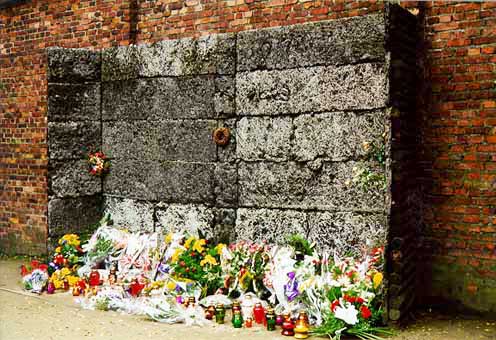
The Black Wall at Auschwitz
is a reconstruction
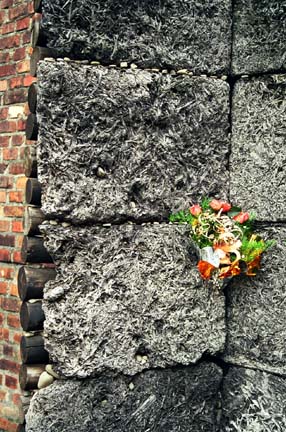 Detail of Black Wall
Detail of Black Wall
Shown in the two photographs above is
the Black Wall with dozens of bouquets of flowers and candles
left by visitors. The photo directly above shows a close-up of
the end of the wall. Notice the small rocks left by visitors.
Many people have noticed that there are
no bullet holes in the wall. That's because this is not the original
black wall; according to my guide, this is a reconstruction which
looks like the original. The original wall was removed after
Arthur Liebehenschel replaced Rudolf Hoess as the camp commander
in November, 1943, and ordered the executions at the wall to
stop.
If you want to walk where millions of
people have trod, including the famous and the infamous, this
is the place. Into this courtyard have walked most of the world
leaders of the Twentieth Century, carrying a wreath of flowers
to place in front of the black wall where the enemies of the
ruthless Nazis were shot over half a century ago.
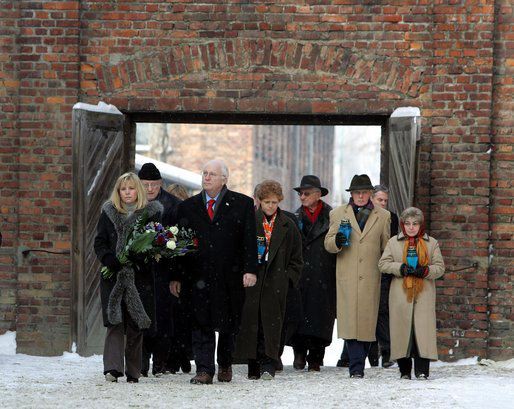 Vice-President Dick
Cheney enters courtyard between Blocks 10 and 11
Photo Credit: White
House photo by David Bohrer
Vice-President Dick
Cheney enters courtyard between Blocks 10 and 11
Photo Credit: White
House photo by David Bohrer
In the photo above Liz Cheney, on the
far left, carries flowers to place at the Black Wall. In the
center of the photo is Deborah Lipstadt, standing next to Dick
Cheney on her left. This photo was taken on January 28, 2005
on the occasion of a visit to Auschwitz by a U.S. delegation
for the ceremonies in honor of the 60th anniversary of the liberation
of Auschwitz on January 27th, 1945.
It was in front of this black wall that
political prisoners, mostly Polish resistance fighters, who had
been convicted by the Gestapo Summary Court, were executed. These
prisoners were brought to the Auschwitz I camp, but were not
registered as inmates; they were housed in dormitory rooms on
the first and second floors of Block 11 while they awaited trial
in a courtroom set up in the building. After they were convicted,
the prisoners were taken to a small washroom in the building
where they were ordered to strip naked, after which they were
marched to the wall in groups of three and executed with one
shot to the neck at close range. Some of the prisoners, who were
sent here, were Czech resistance fighters from the Gestapo prison
at the Small Fortress in Theresienstadt.
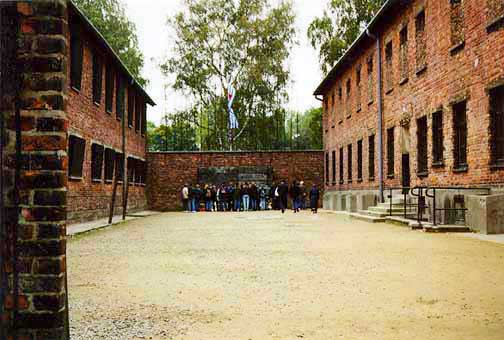
The black wall with
Block 11 on the right, Block 10 on the left
The view of the courtyard in the photo
above was taken through the open wooden gate at the entrance;
it shows a tour group standing in front of the black wall at
the end. Over the top of the wall, you can see a banner or flag
flying. This flag is made out of blue and white striped cotton
material similar to the cloth of the uniforms that the regular
camp prisoners wore, and has a red triangle on it, the badge
of the political prisoners. Camp inmates were also executed at
this wall for resistance activity inside the camp.
To the right in the photo above is Block
11; notice that it has a basement with windows down in concrete
wells. To the left is Block 10 where medical experiments were
done on sterilization of Jewish women, according to the tour
guide. The windows of Block 10 were covered with black-painted
wooden boards so that no one could see what was going on inside,
and the women could not see the activity at the wall. The boards
are angled out a few inches to let in a little light through
the crack at the top.
The photograph below shows the view from
the wall, looking toward the entrance into the courtyard. Block
11 is now on the left and Block 10 is on the right. There is
a wooden gate across the entrance which is open in this picture.

View from the wall,
looking toward entrance to the courtyard
 Windows in Block 10
were boarded up
Windows in Block 10
were boarded up
On my trip to Auschwitz in 2005, a tour
guide told a group of visitors that the two poles in front of
the windows of Block 10 were used for the hanging punishment
in which prisoners were hung by their arms tied behind their
back. This punishment was originated by SS man Martin Sommer
at the Buchenwald camp. It was discontinued in all the camps
by Reichsführer Heinrich Himmler in 1942.
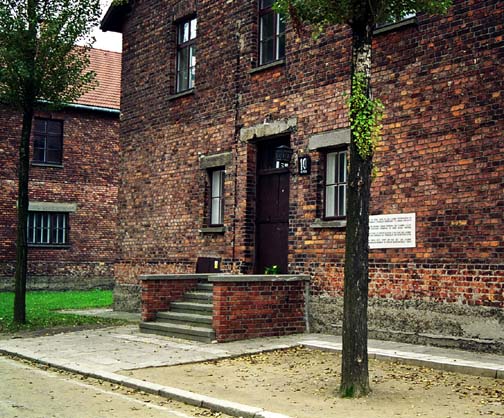 Front entrance to Block
10, the medical building
Front entrance to Block
10, the medical building
The complete records, compiled by the
office of Richard Glücks for all the Nazi concentration
camps in the years 1935 to 1944, are now stored on microfilm
and kept in the Russian Central Archives in the Central State
Archives No. 187603 on Rolls 281 through 286. Richard Glücks
was the head of Amt D: Konzentrationslagerwesen of the WVHA;
he was the highest-ranking "Inspector of Concentration Camps"
in Nazi Germany.
The total number of people executed at
Auschwitz-Birkenau, according to the Nazi records, was 1,646
including 117 Jews, 1,485 Poles, 19 Russians, 5 Czechs and 20
Gypsies, but according to the Auschwitz Museum, there were 20,000
people murdered at the Black Wall in the Auschwitz I camp.
This page was last updated on March 6,
2008
|